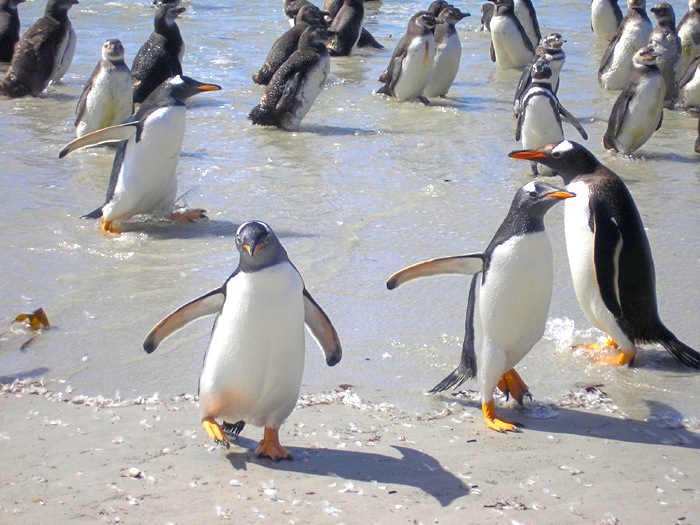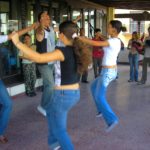After three days of island hopping through the Falklands, I have finally learned the secret to observing penguins: To properly experience these tuxedoed Antarctic birds, you have to cultivate a penguin-like sense of nonchalance.
Thus, when I arrive at Leopard Beach to find a community of 200 or so Magellanic penguins along the waterfront, I simply perch myself on a sand dune and wait. Before long the penguins get used to my presence and resume their wobbling little Magellanic tasks, their black-and-white tuxedos molting off in plumy puffs of gray.
When Charles Darwin came to these islands 178 years ago, he noted that the Magellanic penguin was known locally as a “jackass” penguin, “from its habit,” he wrote, “of throwing its head backward, and making a loud strange noise, very much like the braying of an ass.” The famous naturalist stopped at the Falkland Islands more than a year before his more celebrated visit to the Galapagos Archipelago – and I have journeyed here myself as a side trip from South America, because I believe the Falklands can offer me a nature experience that the Galapagos can’t.
On paper, of course, this British-administered, Connecticut-size archipelago 300 miles off the eastern coast of Patagonia wouldn’t seem to be a more appealing wildlife destination than the Galapagos: There are fewer endemic animal species, a less inviting climate, and no giant lizards to speak of. Moreover, few people know much about these islands beyond the British-Argentine war fought here in 1982 – and even Darwin had reservations about the Falklands, at one point calling the landscape “desolate and wretched.” But things have changed since Darwin’s day – and with upward of 180,000 people visiting the Galapagos each year, efforts to diminish the impact of tourism have resulted in nature experiences that can, at times, feel carefully choreographed and even museum-like. By contrast, the less visited Falklands allow travelers to wander the landscape at will.
So far I haven’t been disappointed with what I’ve found here: Leopard Beach sits on Carcass Island, at the western end of the Falkland archipelago – and on this day it feels as if I have the whole 5-mile by 1-mile isle to myself. I wander the island at whim – inspecting an old shipwreck at Ballast Beach, climbing to the fog-shrouded 880-foot summit of Mount Byng and trekking the treeless spine of the island, occasionally stopping to stretch out on the spongy, heath-like diddle-dee and enjoy a silence so complete it left my ears ringing.
At Leopard Beach, I’ve found that the longer I sit still, the more I see – not just penguins, but more birds than I know how to identify: stocky brown-gray ducks, long-billed shorebirds, buzzard-like foragers, chubby little wrens, stripe-breasted geese.
Near the end of the day, I hike the shoreline back to my homestay inn, shadowed by a curious little brown bird. At dinner, I find myself seated with eight English bird-watchers, half of whom seem to be named “Mike.” I don’t know enough about birds to keep up with their merry ornithological chatter – and they don’t pay me much mind until I mention the brown bird that followed me home.
“Light brown or dark brown?” one of the Mikes asks.
“Dark brown,” I say. “With fairly even coloring.”
“Sounds like a tussock bird,” Mike’s wife says. “When you see them you know you’re on an island that doesn’t have any rats or cats. What else did you see?”
“Well, down near the water, I saw this kind of brownish duck-like bird.”
“Yellow-billed teal?” another Mike offers.
“It had more of an orange bill. And it was kind of stocky. With, like, bluish feathers on its back.”
“Flightless steamer duck!” everybody exclaims.
The Brits diagnose my bird sightings, like surgeons collecting symptoms – for the rest of our meal.
The following morning, I rise early and head down to the boat jetty for a trip across the sound to Westpoint Island – a journey I’ve been anticipating ever since my visit to the Falkland capital Stanley three days ago, when a 70-year-old woman in Deano’s Bar drew me a map of the island. “Go to the cliffs along the western shore,” she’d told me. “You’ll find a sight there you won’t see anywhere outside the Falklands.”
A morning squall hits as the boat shoves off from Carcass Island, so I stand in the wheelhouse with the skipper (who, as it happens, is also named Mike) until the sight of a hulking sea lion sends me back out onto the deck. The sea lion soon splashes back beneath the waves, but when I move to the bow I spot half-a-dozen gray-white Peale’s dolphins. Before long a pair of smaller, black-and-white Commerson’s dolphins join them, and the sight of the two species frolicking is enough to make me forget the rainstorm as we cruise in to Westpoint.
Taking advantage of a break in the weather once on shore, I hop into Skipper Mike’s Land Rover for a drive to the western edge of the island, where I can’t help but smile when I see what the white-haired lady in Stanley told me about. The spectacle looks like something out of Dr. Seuss: Hundreds of huge, regal-looking black-browed albatrosses perched atop their cone-shaped nests while an equal number of rockhopper penguins – looking comically small in comparison – bounce from rock to rock along the cliff’s face, inching their way across the tumbled boulders leading up from the sea.
I’ve read about rockhoppers before – Short and stout, with dark-red eyes and disheveled yellow feathers sticking up from their heads, they look like the hipster punk rockers of the penguin kingdom. By contrast, the albatrosses are a vision of dignity and restraint as they sit on their mud-guano nests and keep watch over their downy chicks.
Resurgent torrents of rain eventually chase me off the cliff, and as Skipper Mike steers the Land Rover away from the bird colony, he spies a couple of “woolies” – unshorn sheep – outside the sheep fence at the top of the ridge. This time of year all the sheep at Westpoint should be “clippies,” and Mike seems preoccupied with the discrepancy as he takes me to his homestead and serves me tea. Seeing this as an opportunity to experience yet another aspect of the islands, I offer to help him round up the woolies.
Half an hour later I find myself creeping across a field, trying to discern the murky logic of sheep behavior. Skipper Mike flanks my moves with the Land Rover, but I’m continually forced to backtrack as the sheep bolt.
The ubiquity of sheep throughout the Falklands is a ready sign that the islands aren’t as pristine as the abundant wildlife might indicate. Livestock was introduced on East Falkland Island as early as 1764 (by the first permanent settlers, French-sponsored Cajun exiles from Nova Scotia), and when Darwin visited in 1833 thousands of wild cattle roamed the countryside.
Interestingly, however, the only indigenous animal to become extinct was the wolf-like Warrah fox – an animal so tame that Darwin predicted it would be “classed with the dodo” a good 40 years before it was indeed hunted out of existence.
After a spirited effort, Skipper Mike and I finally corral the woolies. We head down to the jetty so we can make it back to Carcass Island, where I have a morning flight back to East Falkland.
If there’s one place that represents both the appeal and contradiction of this archipelago as a wildlife destination, it’s Volunteer Beach, which is two hours by road from Stanley on East Falkland Island. Though this beach inhabits a lonesome, bleakly beautiful setting akin to other isolated stretches of the Falkland coastline, I arrive feeling as if I’ve traveled to some kind of windblown Academy Awards gala.
At least, that’s the best analogy to describe the delirious energy of the three dozen British and American travelers here, who grin like starstruck teens as they photograph the nesting colony of king penguins. The velvet rope, in this case, is a ring of whitewashed stones separating penguins from people – and as I join the telephotogenic free-for-all, it feels less like wildlife observation than celebrity worship. Imagine a huge flock of feathery Brad Pitts and Angelina Jolies nonchalantly pooping, preening and regurgitating fish into the mouths of their children in front of Gore-Tex-clad paparazzi, and you get the vibe.
On a direct experiential level Volunteer Beach is a thrill, because it’s one of the few places in the world where you can watch king penguins incubate their eggs in the wild (a 55-day process, wherein mother birds and father birds alternate holding the egg on their feet).
Patrick Watts, a sharp-eyed, soft-spoken 63-year-old Falklander who guides tourists to Volunteer Beach, tells me that big crowds are a relatively new phenomenon. “It took 14 hours of driving through peat bogs and sheep pastures just to get there. New roads have cut the drive down to two hours, so now when a cruise ship calls at Stanley I can drive people out to see king penguins as a day trip.”
While the regal, gold-throated king penguins are inarguably the A-list personalities at Volunteer Beach, they certainly aren’t the only attraction. Hiking down the beach, away from the crowds, we pass Magellanic penguins lounging outside their packed-dirt burrows. By the water, I spot little packs of orange-footed gentoo penguins wobbling and flopping their way up the beach.
Watts tells me that mere cuteness hasn’t always saved the penguins here from human exploitation. “Sealers killed them for oil in the nineteenth century,” he says, as a knot of gentoos toddle past. “As late as 1971, there were only 30 adult king penguins here, but conservation efforts have brought those numbers up over a thousand.”
Watts adds that penguin eggs have long been a delicacy among Falkland natives, and that islanders have learned how to harvest them without affecting bird populations. “I grew up eating them – I liked them fried crispy in the pan. They aren’t used for food much these days, but older people will occasionally collect some for the kitchen.”
Despite Patrick’s revelations, I simply can’t put myself into a mind-frame that would look at a penguin and see a pint of oil (or, for that matter, a Denver omelet). Rather, I find myself impulsively giddy at the simple sight of two dozen white-bellied gentoos padding across the sand at a breakneck jog.
Evolutionary biologists have noted that the waddling gait of penguins triggers the same sense of lovelorn happiness we get when we see human toddlers – and though I’ve never been one to gush at the sight of animals, I wear a grin all the way back to Stanley.





